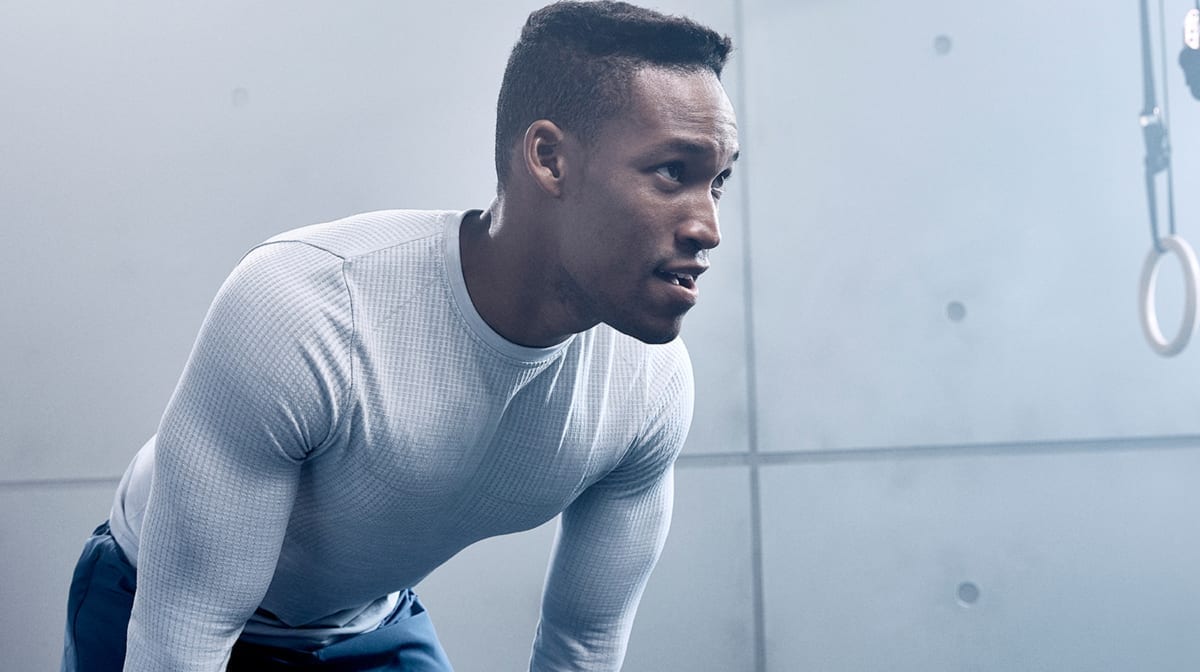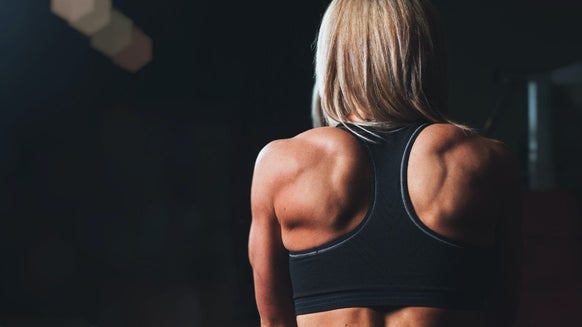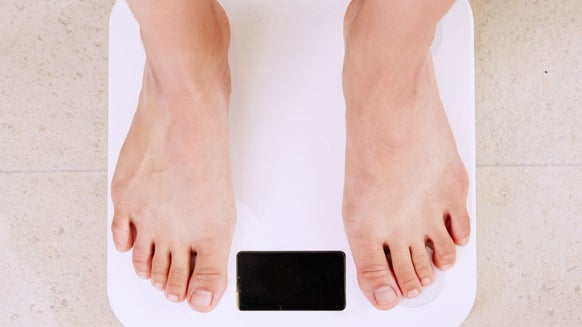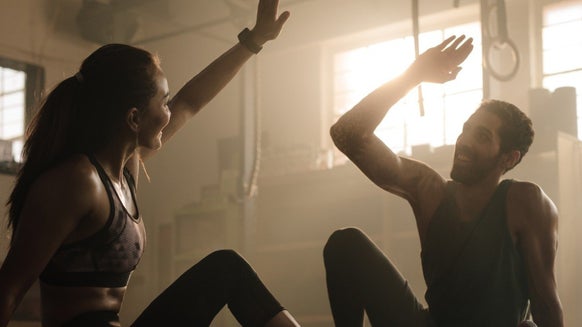
It’s almost guaranteed that the first time you picked up a dumbbell your instinctual reaction was to curl it.
There's a certain fascination people have with building bulging biceps, however, many don’t know how to go about achieving these results and become faced with a muscle-growth plateau.
Often, you see people mindlessly curling away for hours on end only to end up with little or no gains in muscle size.
In this article, we'll break down the various muscles of the upper arm and provide you with the 6 best exercises to really pack on the mass.
You'll find in this article:
Anatomy Of The Upper Arms
In order to build a set of show-stopping arms, you first need to know the muscles you're going to be training and the functions they perform.
The upper arm is made up of two major muscle groups:
- The Biceps
Your biceps are made up of the long head (outer) and the short head (inner) and make up 1/3 of the upper arms.
- The Triceps
The triceps, as the name implies is made up of three heads – the long head, short head and medial head. It also makes up 2/3 of the upper arm, which may come as a surprise to those thinking that the key to bigger arms is working on your biceps.
In order to train the arms for maximal growth, you need to make sure that you're targeting each head of each muscle with a specific set of exercises. Sadly, endless curls are not the secret.
The following 6 exercises, in my opinion, are the best ones for targeting each head.
1) Tricep Dips
This exercise is the king of tricep-builders!
Performing this movement using your bodyweight has the benefit of naturally forcing the muscle to lift an incredibly heavy load, therefore the harder the muscle has to work the more muscle fibres are recruited, leading to more growth.
Not only do tricep dips target all three heads at once but They're performed with a minimum of bodyweight which is significantly greater than what could be handled through an isolation exercise alone.
The movement can be performed on anaerobic exercise step or bench to start off with if your arm strength needs building.
If you have a fair bit of strength in your arms, you can go straight into using a set of parallel bars, mostly located on an assisted pull-up/dip machine.
If this is your first time performing a set of dips on an assisted pull-up/dip machine, it would be wise to set the weight roughly to two-thirds of your original body weight. This can be adjusted once you get into the habit of performing the movement.
a) Approaching the machine, allow your arms to hang down at your sides before wrapping your fingers around the outside of the parallel bars with your thumbs on the inside.
b) Shuffle your wrists into an angle behind you to allow elbows to bend backwards, making sure they keep in line with forearms.
c) If you're using an assisted machine, place knee caps firmly apart on the platform. Slowly lower yourself down until your bicep comes into contact with your forearm to ensure a full stretch in your triceps.
d) Press yourself up fully contracting and squeezing the triceps as you do so.
TIP: To progress with this exercise, start to add additional weight as you get stronger. If you're performing this exercise unassisted, add weight through the use of a weightlifting belt that allows you to add plates, or by placing a dumbbell between your legs.
2) Rope Tricep Pushdown
Tricep pushdowns performed using a cable machine are a great way to target the lateral and medial heads of the triceps. They're considered a key exercise in giving the muscle that desired 'horse shoe' look.
While using a straight or v-bar attachment will allow you to use slightly more weight, the rope attachment helps to isolate the muscle more and receive a much better contraction.
This is not an exercise to go heavy on. Pick a moderate weight.
If not already prepared, clip a rope attachment to the high pulley on a cable machine.
a) Standing upright, bend the top of your torso slightly forward and hold. Grab either side of the rope handles with a normal grip, so that your palms are facing each other. Be prepared to exhale during the following movement.
b) Holding concentration in the triceps throughout the entire move, pull the rope down so that it splits, bringing the handle of each side down to your thighs.
c) Tuck your arms right into your side and remain like this at the end of every rep to eliminate any momentum or help from your back and ensure the triceps are doing all the work. The forearm should be completing the movement.
d) After holding the position for 2 seconds, slowly raise the rope back to the beginning, inhaling as you move your arms back up.
TIP: At full extension of the arms, by turning the wrist away from the body and pulling the ropes apart you can get a great contraction in the triceps. Visualize the rope as a Christmas cracker and try to pull them as far away from each other as possible whilst keeping the elbows tight to the body.
3) Dumbbell Overhead Extensions
A reason many people fail to fully develop their triceps is that they don’t know how to properly target the long head of the triceps.
The long head gets understimulated when it acts as an elbow extensor when the shoulder is adducted or extended, therefore the long head needs to be hit with overhead work.
Dumbbell overhead extensions can be done single-handed, one arm at a time, or two-handed on a single dumbbell.
My recommendation when looking to add mass to the arms would be to use the double-handed variation, as you'll be able to use more weight while still safely getting a good stretch on the eccentric portion of the movement.
This is one of the tricep exercises that can be performed sat down for more balance or stood up.
a) Standing/sitting shoulder width apart, hold a dumbbell with both hands before slowly lifting it over your head, extending both arms out straight.
b) Slightly move the weight between both hands to comfortably allow it to rest in the palm of your hands with thumbs reaching around the bar - your palms should be facing the ceiling. Prepare yourself to breathe in during the upcoming movement.
c) Concentrating on holding your triceps next to your head with elbows tucked in, begin the lower the dumbbell straight down to the floor, feeling the tension in your upper arms when your forearms squeeze against your biceps.
d) As you exhale, squeeze the triceps and slowly lift the dumbbell back to the original starting position. Repeat.
4) Preacher Curl
Made famous by the late Larry Scott, who sported 20” arms at only 5’8, this exercise is probably the greatest biceps isolation exercise there is, as it's almost impossible to cheat the weight up.
This exercise works the long head of the biceps and is responsible for building the peak of the biceps which will create the illusion of the arms appearing much bigger.
Performing with correct form is incredibly important. At first, you'll need to use fairly light to moderate weight as the Preacher curl is not an exercise you can expect to be lifting the heaviest weight with.
Really focus on pulling the weight up with your biceps whilst squeezing at the top.
This can be performed with dumbbells, cable pulley or if you want to use a barbell or EZ curl bar, use a wide grip to emphasise the short head or a narrow grip for more emphasis on the long head.
Perform on a Preacher curl bench, however, if you don't have access to one then you can still put a normal bench on a steep incline and use it to the same effect.
a) Rest your upper arm/arms on the Preacher pad with your chest firmly against it. The palm of your hands should be facing forward, whether you're using a dumbbell, cable, barbell or if you're using an EZ curl bar, your hand/hands should be slightly tilted inwards due to the shape of the bar. If you're using a single arm, rest the other one for support.
b) Chest and arms firmly in place, hold the chosen weight at shoulder length to complete your starting position.
c) Begin to inhale whilst slowly lowering the bar/pulley/weight until your arm/arms are fully extended - enough to feel a deep stretch in your bicep.
d) As you begin to exhale, hold all concentration in squeezing the biceps to curl the weight back up to starting position, in line with your shoulders. At this point, it is important to squeeze the biceps and hold for a couple of seconds.
5) Reverse Cable Curls
Just like a normal cable curl but with an overhand grip!
Once again, you won't be able to go super-heavy on this exercise because the slow eccentrics will really fry and fatigue your muscles. It's critical that you follow the slow eccentrics if you want to see significant muscle gains, as this is how you stimulate the brachialis. The brachialis is a muscle in between your bicep and triceps on the outside of your arm. If you flex your arm you might see a little bump appear.
The brachialis actually runs underneath the bicep and by training it and forcing it to grow you'll actually push your bicep upwards. This is a sneaky way to add some extra size to your arm and therefore it’s crucial that you perform this movement with slow eccentrics as this is what the brachialis responds best to.
Using a straight bar/EZ bar attachment, set the cable pulleys on the bottom pin. The reason for using the cable pulley system for this exercise is that the constant resistance of the cable will keep the tension on your bicep, whereas with a barbell you can rest at the bottom of the movement and lose the muscle tension.
a) Standing upright with a straight torso, hold the straight bar pulley in front of you with a shoulder-width, overhand grip with palms facing down.
b) Keeping elbows close to the torso and upper arms straight, breathe out as you curl the bar towards your head, contracting your biceps to land at shoulder level (only moving your forearms).
c) Hold the contraction for 1-2 seconds, whilst squeezing the muscles.
d) Gradually release the bar, lowering the weight in a slow tempo over a duration of 3-4 seconds. Repeat.
6) Dumbbell Hammer Curls
The final exercise recommendation for building your upper arms is dumbbell hammer curls.
Traditional curls are done with the palms facing forwards, whereas hammer curls consist of the palms facing inwards towards the torso and remaining this way for the entirety of the movement.
This exercise is effective simply because you can use a lot more weight than a standard dumbbell curl which will help to overload the biceps. The brachioradialis, a muscle in the forearm, becomes activated during this exercise in addition to the biceps, essentially having two muscles perform the movement.
My advice would be to use a heavier weight than you can handle for dumbbell curls. The previous two bicep exercises are ones in which you really need to check your ego to get the most out of the movement, however, with hammer curls, you can really push yourself and go as heavy as you possibly can for 8-12 reps.
Lighter weights can be used to start off whilst adjusting to the movement.
a) Standing upright, tighten your core to help keep your back straight and hold a dumbbell in each hand, aligning your arms with your torso with palms facing inwards.
b) Keeping your upper arm next to your torso, breathe out whilst contracting the biceps to curl the dumbbell(s) forward until fully contracted and reaching shoulder level. Squeeze for a moment whilst contracted. Again, for this move, only move your forearm to keep full concentration on the biceps.
c) Squeeze for a moment whilst contracted. Again, for this move, only move your forearm to keep full concentration on the biceps.
d) Begin to slowly release from the contraction, lowering the weights back to your starting position. Repeat.
TIP: Mix this move up a bit with differentiating between variations: using a bench for back support, alternating to single arm dumbbell hammer curls if not already been performed, for increased biceps concentration.
Take Home Message
You may or may not have tried or even heard of these exercises before. Either way, I fully recommend performing them each week to take building your arms up to a new level!







